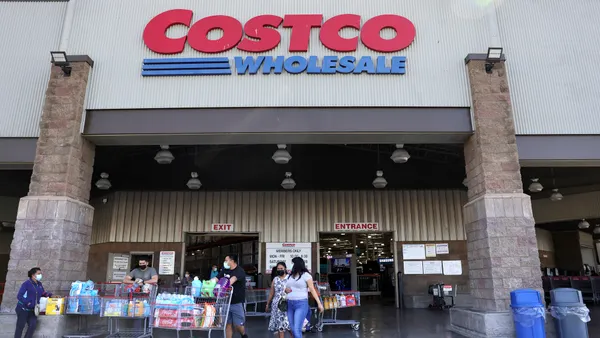Between humans and robots, it's a love/hate relationship. We love robots, but robots also make us nervous. Any time a retailer announces some new use of robots, both in-store and for fulfillment, headlines, and questions, ensue.
Will robots replace workers? Will robots replace workers well? How quickly do they go out of style, out of touch, or out of order?
Robots, many experts say, could become commonplace within retail operations, but they also provide a unique opportunity to enhance the one-on-one interactions between store employees and shoppers. Retail Dive takes a look.
How retailers are using robots
The state-of-the-art in retail robotics is, mostly, in moving items around. A mens clothing store in Seattle, for example, uses robots to fetch items via the store’s mobile app and to get them to dressing rooms within 30 seconds. The store is based on the familiar premise that men don’t like to shop, and clearly wants to help its customers get out of the store quickly. A guy can order and pay for what he picks before he leaves the dressing room.
Perhaps it’s no surprise that the store, Hointer, was founded by Nadia Shouraboura, former chief of supply chain and fulfillment technologies for Amazon, another retailer using robots.
Indeed, Amazon last year said it would be employing some 10,000 robots or even more in its warehouses by the end of 2014. In 2012 the e-commerce giant acquired robot warehouse technology company Kiva Systems Inc., whose robots can find products and bring them to packing stations.
Amazon has been accused of expecting its warehouse employees to reach super-human efficiencies in brutal conditions, so employing actual robots might help the company both with its fulfillment goals and its public relations problem.
And entrepreneur Louis Borders, of Borders bookseller fame, among other enterprises, is working on a robot-powered grocery-delivery service that he says will rely almost solely on robots for fulfillment.
Finally, Lowe’s is taking robots out of the warehouse and onto the floor to actually interact with customers in its Orchard Supply Hardware stores. The “OSHbot” can greet shoppers, converse with them in English and Spanish, bring them to aisles for the products they seek, display specials through images on their "heads", and consult with human Orchard employees that have expertise in home-improvement areas like plumbing.The OSHbot robots were developed with the help of retail-robot and technology startup Fellow Robots.
Why robots?
Retail expert and futurist Doug Stephens, who blogs as the Retail Prophet and wrote The Retail Revival, believes that robots will increasingly be helpful to retailers.
That retailers pay their workers so little is, perhaps surprisingly to many, one reason that robots could be even more appealing. The pushback by worker advocates and policymakers against low retail wages and punishing work schedules is actually an incentive for retailers to start using robots, who take being treated like robots without complaint.
But robots have their limits
Still, robots can’t do everything as well as or better than humans. Even Stephens notes this, writing last year:
In fact, there have been some extremely compelling studies that clearly show that robotics and cognitive computing power alone are often not the best solutions to complex problems.
For one thing, robots tend not to have very good fine motor skills, making the manipulation and demonstration of complex objects very difficult and slow. Meanwhile, artificial intelligence is great at retrieving factual data and solving linear problems but not so adept at intuiting creative and sometimes lateral solutions, much less forging an emotional connection with a customer. Technology, on its own, tends not to be the optimal solution.
The 'one-to-one solution' in guests' pockets
Customers already have access to technology that retailers may find even more effective than robots, at least in stores, David Lloyd, president of virtual agent software firm IntelliResponse, told Retail Dive. Robots are excellent for folding shirts, returning items to shelves, or working in warehouses, he says.
But many of the other, customer-facing jobs that we think robots could do can actually be better taken care of through a store’s mobile app, backed up by superb data, thanks, says Lloyd, to “a shard of glass that everyone’s carrying around, called a mobile device.”
“The machine-learning, virtual assistant can potentially personalize the experience for you,” he says. “There’s a one-to-one solution in our pocket that knows about you. We’re talking about augmenting and improving that customer experience with information.”
Robots enhancing human interactions
In fact, what robots may do best when it comes to retail is help retail workers do their jobs better, experts told Retail Dive. In retail anyway, says Brett Wickard, founder-president of lean retail platform FieldStack, “technology doesn’t displace people — it amplifies them.”
“Even yesterday’s technology amplifies people — the speedy credit card transaction that allows a clerk a few extra seconds to connect with a customer and reinforce their store’s brand while closing the sale,” Wickard says. “Or the instant access to detailed information about inventory that allows the clerk to utilize their fantastic interpersonal skills instead of just their product knowledge. People have been designing and utilizing more and more sophisticated tools since the beginning of time, and robotics is just another step on that journey. ”
Like Lloyd and Stephens, Wickard says the state-of-the-art for robots in retail is to use them for the jobs that may not pay well, may be monotonous, and could be easily taken care of through robotics. The benefit is that employees are then free to do what humans in retail do best.
“Robotic store cleaning allows retail teams to spend more time on their core strengths – selling and merchandising,” he says.“Robotic store night security allows more goods to be merchandised in more ways with lower stress on the retail team. Robotic sorting allows retail teams to focus on merchandising. Many repetitive tasks at retail that don’t require creativity or thoughtful consideration are likely candidates for future robotic/technological advances."
"So while many more robotic advances continue in the warehousing/fulfillment space, more financially feasible robotic assistants at brick and mortar retail are likely to continue developing over the coming years.”
State-of-the-art for humans in retail
While brick-and-mortar retailers would seem to have the advantage against Amazon when it comes to customer service, that’s not necessarily so. Many retailers over-estimate their store employees and under-appreciate the training they need. Amazon, meanwhile, has honed its machine learning — in item descriptions, suggestions of other products, and reviews — to provide the kinds of information that customers seek, most often without even asking.
What that means for many retailers, says Doug Stephen (not the Retail Prophet), SVP of the Learning Division at business solutions and learning company CGS, is ensuring that employees are well trained in the available technologies and in how best to interact with customers, with or without those technologies. That might mean better training, better working conditions, and better pay — for better employees.
And, again, that’s where technology, robots, mobile capabilities — and data — come in.
“Customers use technology more and more within retail locations, be it their own or the store’s. Most customers are comfortable with all the technology in their pockets, and access retailer’s apps and web stores while shopping,” Wickard says. “So it’s easy to imagine in-store technology like kiosks adding more features and becoming mobile/robotic — allowing the retail staff to assist even more customers.”.
“And, like technology, data can amplify retail clerk’s ability to serve customers,” he adds. “With great data, a courteous retail clerk transforms into a clienteling genius.”






















